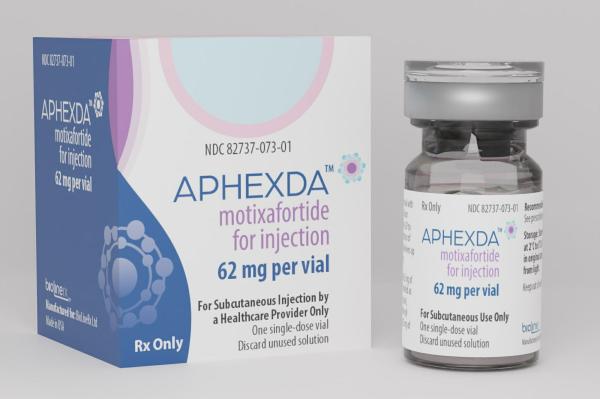Aphexda Side Effects
Generic name: motixafortide
Medically reviewed by Drugs.com. Last updated on Feb 4, 2025.
Note: This document provides detailed information about Aphexda Side Effects associated with motixafortide. Some dosage forms listed on this page may not apply specifically to the brand name Aphexda.
Applies to motixafortide: subcutaneous powder for solution.
Precautions
It is very important that your doctor check your progress at regular visits to make sure this medicine is working properly. Blood tests may be needed to check for unwanted effects.
Using this medicine while you are pregnant can harm your unborn baby. If you are a woman who can get pregnant, your doctor may do tests to make sure you are not pregnant before starting treatment. Use an effective form of birth control to keep from getting pregnant during treatment and for 8 days after the last dose. If you think you have become pregnant while using this medicine, tell your doctor right away.
This medicine may cause serious allergic reactions, including anaphylaxis, which can be life-threatening and require immediate medical attention. Tell your doctor right away if you have a rash, itching skin, dizziness, lightheadedness, or fainting, feeling of warmth, redness of the face, neck, arms and occasionally, upper chest, nausea, swelling of the face, tongue, or throat, trouble breathing, chest pain, or vomiting after you receive the medicine.
This medicine may cause injection site reactions. Check with your doctor right away if you have bleeding, blistering, burning, coldness, discoloration of skin, feeling of pressure, hives, infection, inflammation, itching, lumps, numbness, pain, rash, redness, scarring, soreness, stinging, swelling, tenderness, tingling, ulceration, or warmth at the injection site.
Serious side effects of Aphexda
Along with its needed effects, motixafortide (the active ingredient contained in Aphexda) may cause some unwanted effects. Although not all of these side effects may occur, if they do occur they may need medical attention.
Check with your doctor or nurse immediately if any of the following side effects occur while taking motixafortide:
More common side effects
- bleeding, blistering, burning, coldness, discoloration of skin, feeling of pressure, hives, infection, inflammation, itching, lumps, numbness, pain, rash, redness, scarring, soreness, stinging, swelling, tenderness, tingling, ulceration, or warmth at the injection site
- blurred vision
- chest tightness
- chills
- confusion
- cough
- decreased urine
- difficulty in breathing or swallowing
- dizziness
- dry mouth
- eye pain
- fast heartbeat
- feeling of warmth
- fever
- general feeling of illness
- headache
- increased thirst
- loss of appetite
- mood changes
- muscle pain or cramps
- nausea or vomiting
- nervousness
- numbness or tingling in the hands, feet, or lips
- pounding in the ears
- puffiness or swelling of the eyelids or around the eyes, face, lips, or tongue
- redness of the face, neck, arms, and occasionally, upper chest
- seizures
- shakiness in the legs, arms, hands, or feet
- skin itching, rash, or redness
- sore throat
- swelling of the face, throat, or tongue
- trembling or shaking of the hands or feet
- unusual tiredness or weakness
Other side effects of Aphexda
Some side effects of motixafortide may occur that usually do not need medical attention. These side effects may go away during treatment as your body adjusts to the medicine. Also, your health care professional may be able to tell you about ways to prevent or reduce some of these side effects.
Check with your health care professional if any of the following side effects continue or are bothersome or if you have any questions about them:
More common side effects
- back pain
- burning, crawling, itching, numbness, prickling, "pins and needles", or tingling feelings
- cracked, dry, scaly skin
- ear swelling
- swelling
See also:
For healthcare professionals
Applies to motixafortide: subcutaneous powder for injection.
General adverse events
Most common adverse reactions (incidence greater than 20%) are injection site reactions, injection site pain, injection site erythema, injection site pruritus, pruritus, flushing, and back pain.[Ref]
Cardiovascular
- Frequency not reported: Hypertension
Dermatologic
- Very common (10% or more): Pruritus (38%), rash (16%), urticaria (14%), erythema (12%)
- Frequency not reported: Dermatitis exfoliative generalized
Rash included rash erythematous, rash maculo-papular, rash papular and rash pruritic.
Gastrointestinal
- Very common (10% or more): Nausea (14%)
Hematologic
- Very common (10% or more): Flushing (33%)
- Frequency not reported: Leukocytosis
Flushing included hot flush.
Hypersensitivity
- Frequency not reported: Anaphylactic shock and hypersensitivity reactions
Local
- Very common (10% or more): Injection site reactions (73%; injection site pain [53%], injection site erythema [27%], injection site pruritus [24%])
Injection site reactions included injection site bruising, injection site discomfort, injection site erythema, injection site induration, injection site mass, injection site nodule, injection site pain, injection site pruritus, injection site rash, injection site swelling, injection site urticaria, injection site cellulitis and injection related reaction.
Metabolic
- Very common (10% or more): Hypokalemia (15%)
Musculoskeletal
- Very common (10% or more): Back pain (21%)
Back pain included spinal pain and sacral pain.
Nervous system
- Very common (10% or more): Paresthesia (19%)
- Frequency not reported: Dizziness, tremor
Paresthesia included paresthesia oral, hypoesthesia, hypoesthesia oral and burning sensation.
Other
- Frequency not reported: Ear swelling, pyrexia, chills
References
1. (2023) "Product Information. Aphexda (motixafortide)." BioLineRx USA Inc
More about Aphexda (motixafortide)
- Check interactions
- Compare alternatives
- Pricing & coupons
- Drug images
- Dosage information
- During pregnancy
- FDA approval history
- Drug class: hematopoietic stem cell mobilizer
- En español
Patient resources
Professional resources
Related treatment guides
Further information
Aphexda side effects can vary depending on the individual. Always consult your healthcare provider to ensure the information displayed on this page applies to your personal circumstances.
Note: Medication side effects may be underreported. If you are experiencing side effects that are not listed, submit a report to the FDA by following this guide.

